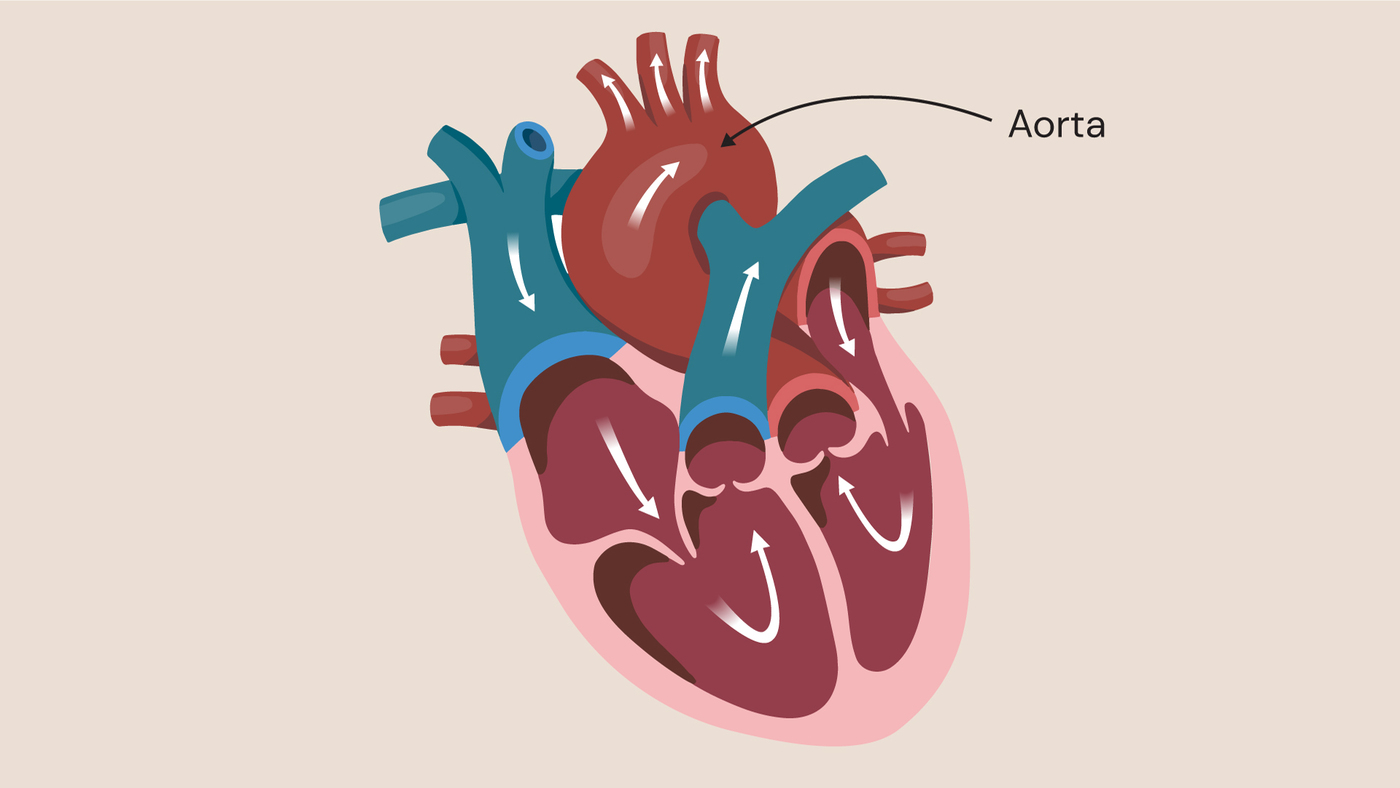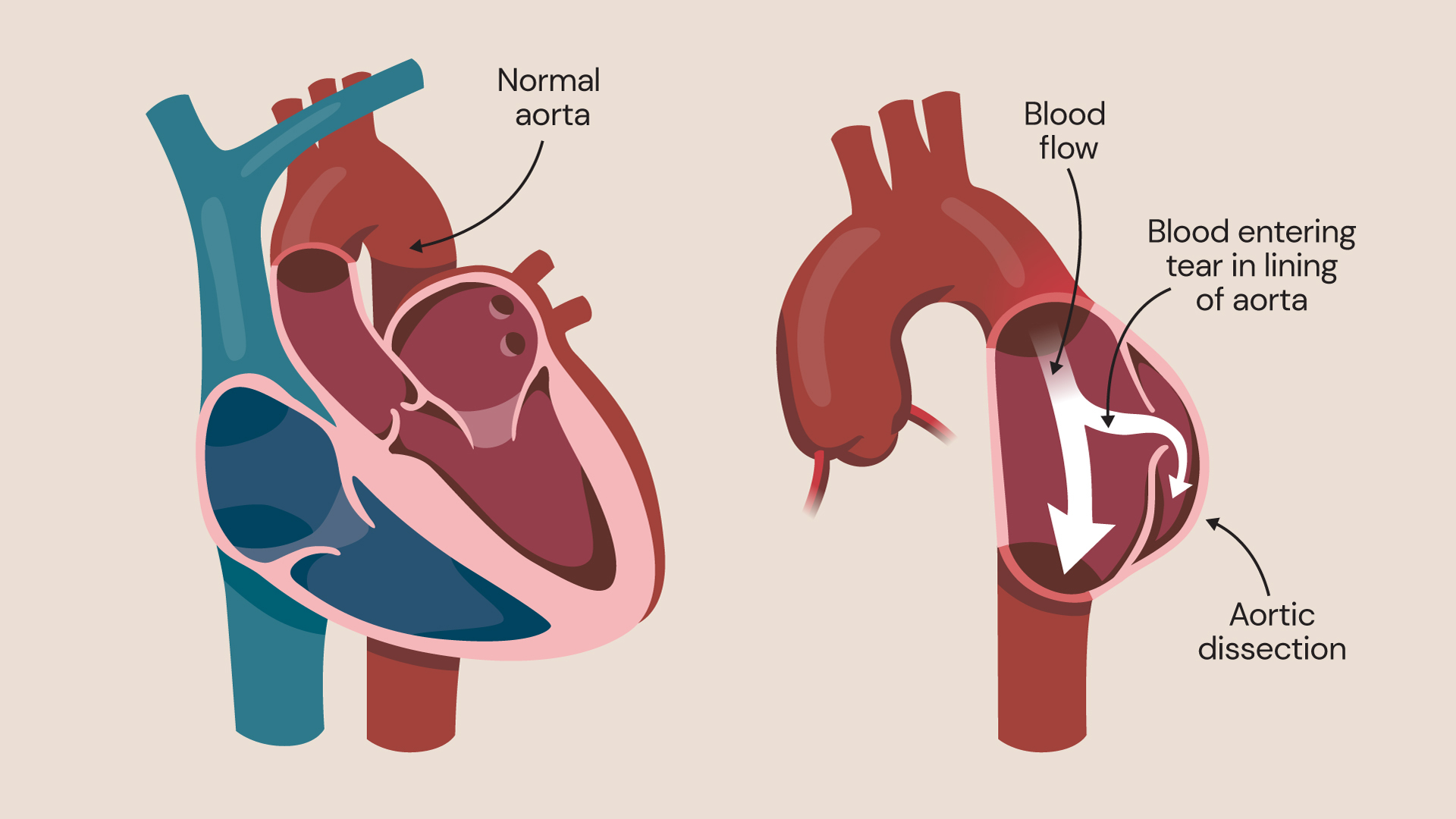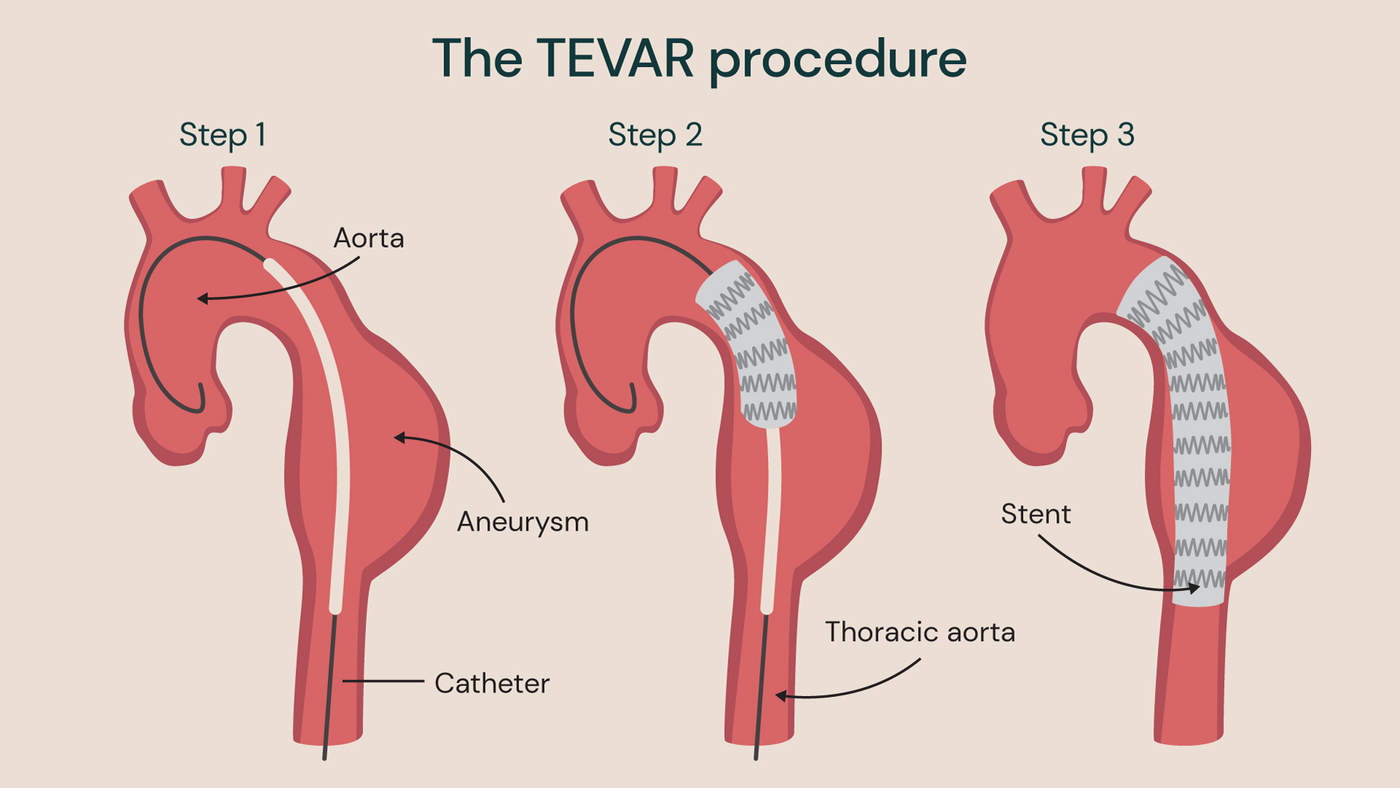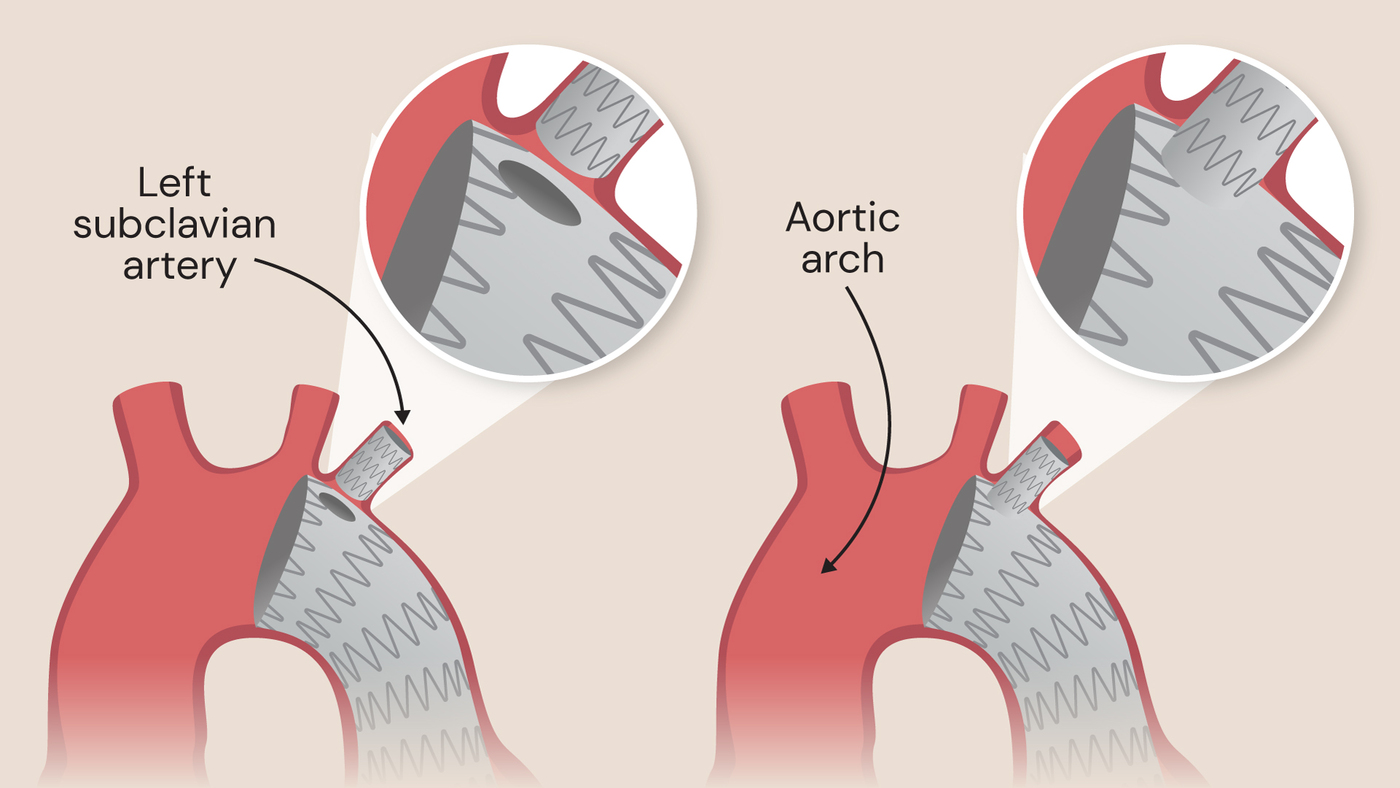If you have a thoracic aortic aneurysm or aortic dissection, your doctor may recommend a minimally invasive procedure called TEVAR. TEVAR, or Thoracic EndoVascular Aortic Repair, is a relatively new technique that uses a stent-graft to reinforce and repair a weakened section of the aorta.
What is the TEVAR procedure?
TEVAR, or Thoracic EndoVascular Aortic Repair, is a minimally invasive surgical procedure used to treat thoracic aortic aneurysms and aortic dissection. These are both serious conditions affecting the aorta, the largest blood vessel carrying oxygenated blood from the heart to the rest of the body.
It involves the insertion of a stent graft through a small incision in the groin, which is then guided through blood vessels to the affected area of the aorta. The stent graft reinforces the weakened or damaged aortic wall, allowing blood to flow through the graft, thus diverting pressure away from the weakened section.
TEVAR has become a preferred alternative to traditional open surgery for thoracic aortic aneurysms and dissections due to its reduced risk of complications, shorter recovery time, and improved patient outcomes.

The structure of the human heart, including the aorta, showing directions of blood flow.
Why might I need TEVAR?
A thoracic aortic aneurysm is when the part of the aorta in the chest becomes enlarged. There are three types of thoracic aortic aneurysm which TEVAR can treat; ascending, descending and arch.
An ascending aortic aneurysm occurs in the part of the aorta that extends upwards from the heart. This type of aneurysm can cause the aortic valve to leak and is more commonly diagnosed in older patients.
A descending aortic aneurysm forms in the section of the aorta which is in the lower part of the chest and extends down towards the abdomen. An aortic arch aneurysm occurs in the curved top section of the aorta and can affect the vital blood vessels which supply blood to your head and neck.

Aortic arch aneurysm, ascending aortic aneurysm and descending aortic aneurysm.
A thoracic aortic aneurysm often develops slowly with no symptoms but, if the aneurysm grows too large, it can rupture, threatening the life of the patient and requiring emergency treatment. After an aneurysm ruptures, mortality can be as high as 54% at 6 hours after onset, and 76% at 24 hours.
Another condition, called aortic dissection type B can also be treated with TEVAR. There are two types of aortic dissection – type A and type B. Aortic dissections are when a tear occurs in the inner layer of the aortic wall.

Healthy aorta (left) and type B aortic dissection (right).
In most cases, type A dissection is urgent and requires surgery immediately to repair the aorta. Type A dissection usually occurs in the section of the aorta closest to the heart and can be life-threatening if treatment is not sought quickly.
Type B dissection occurs further down the aorta, further away from the heart, and it is patients with this type of dissection who typically benefit from TEVAR. Surgery for type B dissection is not always immediately required, especially if the dissection does not severely affect the patient’s blood flow. The fact that type B dissection is less urgent than type A allows more time for these patients to be recommended for and to undergo TEVAR surgery
How to prepare for TEVAR
TEVAR was initially developed for treating aneurysms in the descending aorta, but the procedure can also be used in emergency cases to treat the ascending aorta. An example of when this rare scenario may occur is if the patient may not survive traditional open surgery, either due to their age or fragile condition.
Traditional TEVAR is designed for descending aortic aneurysms and type B dissections, with the stent graft placed in the lower section of the aorta. The stent scaffolds this weakened part of the aorta and allows blood to flow through the strengthened section, removing pressure from the weakened aortic wall.

TEVAR procedure with a stent in place to treat a descending aortic aneurysm.
Although the TEVAR procedure is very successful for the treatment of type B aortic dissection, up to 2% of patients may experience a new tear in their aorta, or the stent graft may move over time to re-expose the original tear. If this occurs, we can offer a minimally invasive procedure called FLIRT to seal the tear.
Our consultants developed this new interventional technique to mitigate complications with the TEVAR procedure. This provides our patients with an end-to-end solution for aortic repair, while also protecting the aorta from movement of the stent later in the patient’s life.
Unibody single branch stent graft for descending aortic arch aneurysms
When the aneurysm occurs in the aortic arch, more than just a standard stent (as pictured above) is required. A stent for the subclavian artery at the top of the arch must also be included, in order to preserve the blood flow and ensure that the head and neck continue to be supplied with blood.
Previously, two stents were used in these scenarios – one for the aortic arch, and one for the subclavian artery. While in most cases this was a good solution, in 10-15% of cases, one or both of the stents slipped, allowing blood to leak in between the stents, requiring reintervention.
We are proud to offer an innovative new treatment to combat this issue, performing TEVAR using a unibody single branch stent graft which incorporates an additional branch sewn into the main stent. This forms a unibody, with the single-branch directed into the subclavian artery to protect it. This means that the stent graft is manufactured in one piece, with no risk of blood leaking between the two parts of the stent.
This innovative new form of TEVAR is offered at Royal Brompton Hospital by our world-renowned consultant cardiologist, Professor Christoph Nienaber, and eliminates the need for further intervention later in the patient’s life.

Standard separate side-branch (left) and unibody side-branch device (right).
Nexus stents for aortic arch aneurysms
When the aneurysm occurs in the aortic arch, the Nexus stent (consisting of 2 components) can be used. In these cases, a surgeon performs a carotid crossover bypass, which is a procedure to maintain blood flow to the brain and prevent a stroke. After this, the first part of the Nexus stent is inserted through a catheter into the aorta, before the second part of the stent follows and is slotted into place overlapping with the first part.
We are proud to offer a comprehensive package of aortic care, with innovative treatment options available for a number of aortic diseases.

Nexus stent which is used for ascending aortic arch aneurysms.
Who is TEVAR suitable for?
TEVAR is typically recommended for older patients who have a thoracic aortic aneurysm, aortic dissection, or other aortic condition. The recovery period associated with open surgery carried out (as a TEVAR alternative) is longer and more difficult, which is why TEVAR is recommended to older patients.
However, the results of TEVAR may also require reintervention later in life, for example if the stent slips out of position in the aorta or, if an endoleak develops. This is why the procedure is not commonly recommended to young patients (with connective tissue disorders) who are able to undergo open surgery and recover from it sooner than older patients can.
What happens in the TEVAR procedure?
Before undergoing the procedure, you’ll meet with your consultant surgeon or interventional specialist for a preoperative evaluation. This may include a physical exam, blood tests, and imaging tests, such as a CT scan or a cardiac MRI.
Your consultant will review your medical history and medications to ensure that the procedure is a good option for you. You’ll also receive instructions on how to prepare for the procedure, such as fasting before the procedure and stopping certain medications.
TEVAR is performed under general anaesthetic, so you’ll be asleep during the procedure. It typically takes around 90 minutes to complete.
Your surgeon will make a small incision in your groin area and thread a catheter through a blood vessel to the aorta. They’ll then insert the stent-graft into the weakened section of the aorta.
The surgeon will use imaging tests, such as X-rays, to guide the stent-graft into place. Once the stent-graft is in place, the surgeon will remove the catheter, and the incision will be closed with stitches or adhesive strips.
After the procedure, you’ll be taken to a recovery room where you’ll be closely monitored for a few hours. You’ll need to lie flat and keep your legs straight for several hours to allow the incision site to heal properly. You may experience some pain or discomfort in the groin area, which can be managed with pain medication.
You’ll likely stay in the hospital for a few days for further monitoring and to ensure that there are no complications before being discharged. Most patients require around three weeks to recover at home before returning to daily activities.
Benefits of TEVAR
TEVAR has several benefits over open surgery, which is why it’s now the recommended procedure for aortic repair, as an alternative to traditional open surgery.
Smaller incisions: TEVAR requires only a small incision in the groin, rather than a larger incision in the chest.
Shorter hospital stays: TEVAR typically requires a shorter hospital stay than open surgery.
Faster recovery time: As TEVAR is less invasive than open surgery, recovery time is typically faster, with most patients able to return to their normal activities within a few weeks.
Lower risk of complications: Because TEVAR is less invasive, there is a lower risk of complications such as infection, bleeding, and stroke compared to open surgery.
Risks of TEVAR
However, like all medical procedures, TEVAR comes with some risks and potential complications. Possible risks and complications include:
- bleeding at the incision site
- blood clots
- damage to blood vessels or organs
- infection
- leaking around the stent-graft
- stroke
Most of these complications are rare, but it’s important to be aware of them. Your surgeon will discuss the risks and benefits of the procedure with you in detail before you decide to have TEVAR.
Is TEVAR right for me?
If you have a thoracic aortic aneurysm, type B aortic dissection, or other aortic condition, TEVAR may be a good option for you. It’s a minimally invasive procedure that can repair a weakened section of the aorta and prevent potentially life-threatening complications.
If you’re considering TEVAR, speak to your doctor about whether it’s the right option for you. With proper preparation and monitoring, TEVAR can be a safe and effective treatment for many patients.
Locations
The TEVAR procedure is available with our specialists at:
Meet our cardiology specialists
Meet our team of renowned cardiology specialists. From cardiovascular health assessments to innovative interventions, our experts are committed to delivering personalised care designed just for you.
